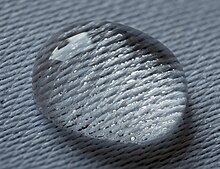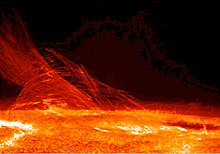
Back Superficie (física) Spanish Superficie (fisica) Italian 表面 Japanese Поверхность (физика) Russian



A surface, as the term is most generally used, is the outermost or uppermost layer of a physical object or space.[1][2] It is the portion or region of the object that can first be perceived by an observer using the senses of sight and touch, and is the portion with which other materials first interact. The surface of an object is more than "a mere geometric solid", but is "filled with, spread over by, or suffused with perceivable qualities such as color and warmth".[3]
The concept of surface has been abstracted and formalized in mathematics, specifically in geometry. Depending on the properties on which the emphasis is given, there are several non equivalent such formalizations, that are all called surface, sometimes with some qualifier, such as algebraic surface, smooth surface or fractal surface.
The concept of surface and its mathematical abstraction are both widely used in physics, engineering, computer graphics, and many other disciplines, primarily in representing the surfaces of physical objects. For example, in analyzing the aerodynamic properties of an airplane, the central consideration is the flow of air along its surface. The concept also raises certain philosophical questions—for example, how thick is the layer of atoms or molecules that can be considered part of the surface of an object (i.e., where does the "surface" end and the "interior" begin),[2][4] and do objects really have a surface at all if, at the subatomic level, they never actually come in contact with other objects.[5]
- ^ Sparke, Penny & Fisher, Fiona (2016). The Routledge Companion to Design Studies. New York: Routledge. p. 124. ISBN 9781317203285. OCLC 952155029.
- ^ a b Sorensen, Roy (2011). Seeing Dark Things: The Philosophy of Shadows. Oxford: Oxford University Press. p. 45. ISBN 9780199797134. OCLC 955163137.
- ^ Butchvarov, Panayot (1970). The Concept of Knowledge. Evanston: Northwestern University Press. p. 249. ISBN 9780810103191. OCLC 925168650.
- ^ Stroll, Avrum (1988). Surfaces. Minneapolis: University of Minnesota Press. p. 205. ISBN 9780816616947. OCLC 925290683.
- ^ Plesha, Michael; Gray, Gary & Costanzo, Francesco (2012). Engineering Mechanics: Statics and Dynamics (2nd ed.). New York: McGraw-Hill Higher Education. p. 8. ISBN 9780073380315. OCLC 801035627.
© MMXXIII Rich X Search. We shall prevail. All rights reserved. Rich X Search